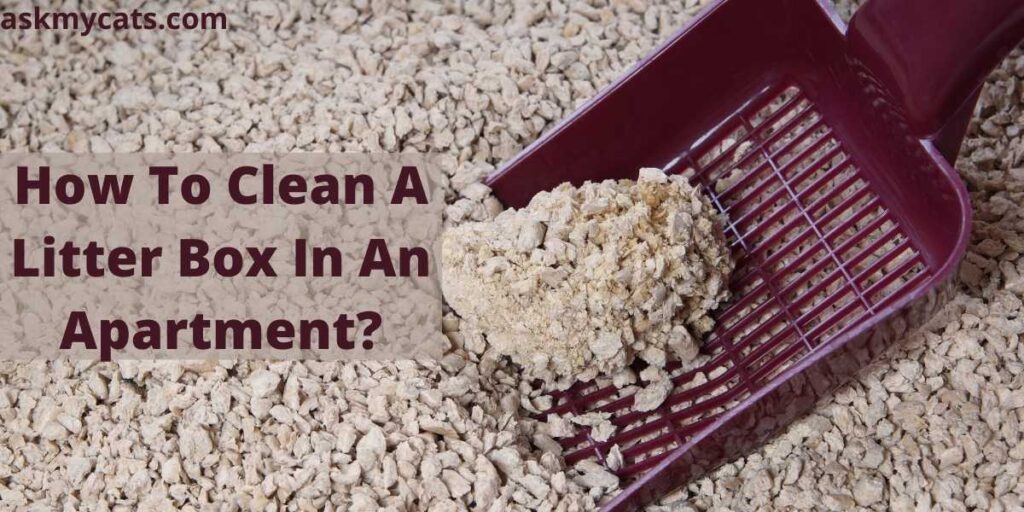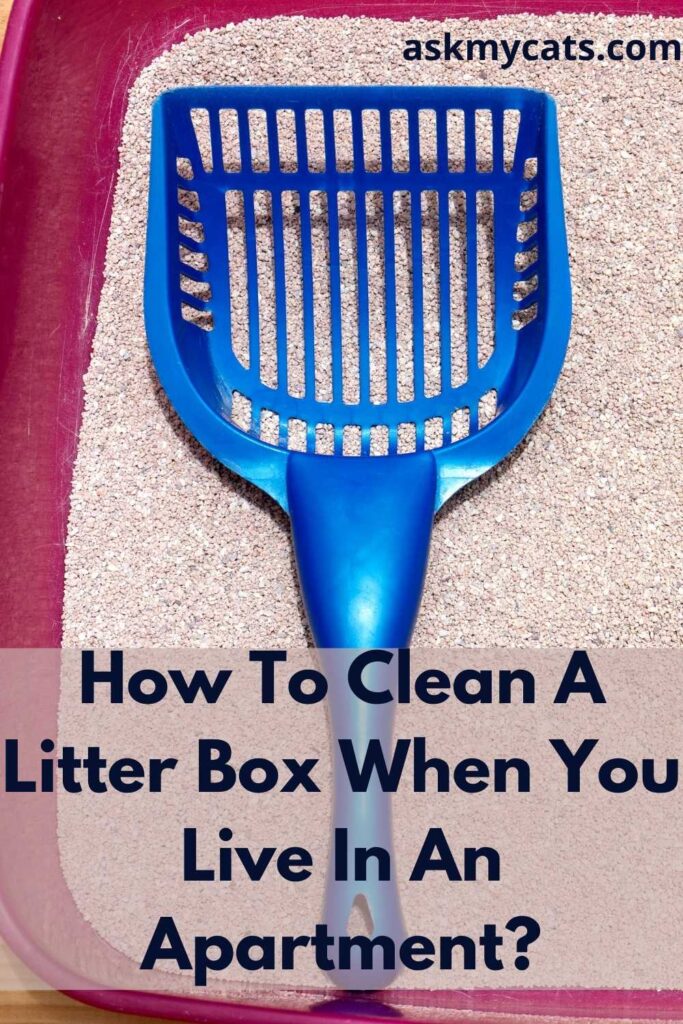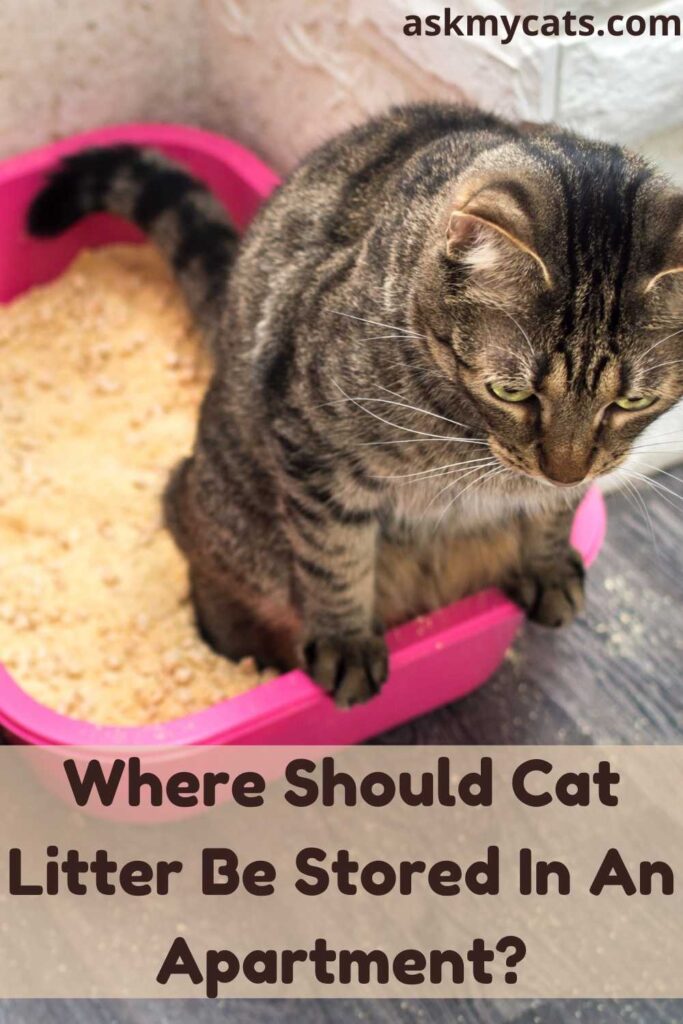Every cat owner must learn how to properly clean up after their cat. Litter boxes are useful in this situation. If you live in an apartment, though, cleaning litter boxes can be difficult.
You normally don’t have access to a backyard or an outdoor area. Avoid dumping the litter box in a sink or bathtub in this situation. From a health standpoint, that is simply not acceptable.
So, how to clean a litter box in an apartment.
You can clean a litter box in an apartment by using natural pet-specific wipes, Using disposable litter boxes, or Purchasing a self-sanitizing litter box.
Keep reading the article to know more in-depth about the ways to clean your cat’s litter box in an apartment.


Give Your Cat the Perfect Day
Get the Free Ebook!
How To Clean A Litter Box When You Live In An Apartment?
Here are some ways to clean a litter box when you live in an apartment: –

1. Use Pet Wipes
Use pet wipes to keep the litter box clean every day in a quick and simple manner.
Wipes that are specifically made for your cat and include only natural components are available.
This guarantees that the pet wipe will be soft and nice to your cat.
When it comes to pet wipes, don’t try to save money by cutting corners.
Don’t use it if it contains harsh chemicals or citrus fragrances. Citrus irritates cats.
The biggest disadvantage of “organic” pet wipes is their high price and rarity in stores. However, if you want the increased convenience, they are worth considering.
If your local pet store doesn’t provide organic pet wipes, consider looking online. Most internet stores have wipes made with natural substances, so you won’t have to go to the store.
2. Use Disinfectant Wipes
If your cat isn’t a fan of the fragrances contained in commercial wipes, a disinfecting wipe is a good alternative. Using disinfectant wipes has a number of advantages.
For starters, keeping the litter box chemically sanitized and smelling fresh is much easier. Second, disinfection wipes don’t usually have smells that are bothersome to cats.
Chemical disinfectant wipes are okay to use in locations that your cat may come into touch with, as long as they are rinsed well afterward.
This is a crucial step because the residue left behind by these wipes can be harmful to cats if left to sit for too long.
You can either splash a tiny amount of water or wipe it down completely with wet paper towels to remove the residue left behind after emptying your litter box and scrubbing it with disinfectant wipes. Before adding new litter, make sure the box is totally dry.
Disinfectant wipes are deemed safe to use because they eliminate hazardous viruses and germs. You must, however, rinse the litter box with water to eliminate any residue.
Disinfectant wipes include chemicals that might be harmful to cats if they come into contact with them. Wipe the litter box with wet paper towels after emptying and disinfecting it.
Refill the litter box with fresh litter before letting your cat to use it again.
Avoid using scented wipes because they may cause your cat discomfort.
3. Use Sponge
Since there isn’t exactly a safe place to discharge the polluted water inside an apartment, any litter box cleaning should be done with as little water as possible.
If you don’t have any sanitizing wipes on hand and would rather utilize a common kitchen item, soap and a sponge could be an acceptable substitute.
To complete the task, use a general-purpose sponge and a light non-scented detergent. To make suds, simply wet the sponge just enough.
After you’ve finished emptying the litter box, use the sponge to scrub the entire surface. Wipe the moist litter box with a cloth as soon as possible.
Before refilling with clean litter, make sure the litter box is completely dry. Soap residue on the litter box is a no-no.
The sponge should now be discarded because it is too polluted to be used again. Simply throw it away and replace it with a clean one for the next time.
When cleaning, try to use as little water as possible. The last thing you want is for waste to contaminate the water supply.
The soap and sponge solution is only designed to be used temporarily. Cleaning the litter box with specially prepared cat wipes is advised.
4. Use Flushable Wood-Pellet Litter
This is a fantastic little hack that makes cat litter care a lot easier. Wood pellets can be used instead of regular clay litter. It’s unlikely that your cat will enjoy it, but it’s a viable option.
Simply offer your cat a new flush when you notice it has relieved itself. Grab the poop with toilet tissue and flush it. Simply spray the litter box area with unscented bio-based solutions to clean it.
If the litter box emits foul odors or includes sawdust, this rule does not apply. Instead of flushing the pellets, you should throw them away in the trash.
Wood pellets are prone to crumbling into sawdust, which is a common disadvantage. Cross-contamination with litter dust and on your skin is the last thing you want.
When working with sawdust litter, remember to wear a mask and gloves. What’s the point of wearing a mask? Because cats produce ammonia, which can be toxic to humans.
5. Try Biodegradable Litter
Biodegradable litter is manufactured from environmentally friendly materials such as recycled newspaper, sawdust, and wood. It’s not only gentler for your cat, but it’s also simple to clean up afterward.
This type of litter, on the other hand, is more expensive than typical clay litter.
Eco-friendly garbage is typically totally biodegradable and compostable, so it’s worth thinking about. You might want to produce your own cat litter if you’re concerned about the environment and want to save money.
This is accomplished by repurposing commonplace materials that would otherwise be disposed of in landfills.
You may learn how to accomplish it from a variety of online tutorials. Cat litter can also be used to make healthy compost.
6. Use Disposable Litter Box
Disposable litter boxes are constructed of plastic or paper that has been recycled. They’re particularly beneficial because they include litter. These boxes are readily available at any pet store in your area.
The best feature is the low cost of these boxes, which is especially advantageous when purchasing in quantity. They usually last for about 30 days (or as long as the manufacturer specifies).
Pour 2-3 inches of litter into the disposable box to keep the waste afloat.
You want the waste to be removed from the bottom. Once a day, scoop the excrement and pee away using a shovel and waste bag. This will keep odors and hygiene problems at bay.
Use a shovel to scoop up pieces of pee and place them in an airtight container. Alternatively, you can discard them into garbage landfills in a biodegradable trash bag.
To dispose of feces, flush them down the toilet. To prevent feces from spilling out, place a tissue below.
After the 30-day period has passed, simply throw them away.
After that, there’s no need to clear up the litter. If you’re on a budget or traveling, these disposable litter boxes are ideal.
7. Use A Automatic Litter Box
The only reason this option is at the bottom of the list is that it is costly and difficult to install. While the convenience of a self-sanitizing litter box is unrivaled, you should budget at least a couple hundred dollars for the box and the particular litter you’ll need to use it.
These complicated devices are typically costly and difficult to install. While the convenience is unrivaled, you should budget for a significant outlay.
Several hundred dollars will be spent on the greatest self-cleaning litter boxes.
A cold-water connection, an electrical outlet, and a toilet are also required for the self-sanitizing litter box. For installation, you may need to engage a skilled plumber and electrician.
This will allow the self-cleaning litter box to dispose of waste without the need for human interaction.
When you think about it, self-cleaning litter boxes are technological marvels. They dispose of solids automatically and frequently use dust-free, washable litter.
However, some models are a little more expensive. The machine, if properly mounted, should be able to clean the entire litter box. Using a cleaning solution and water, this is accomplished.
The waste is subsequently flushed down the toilet drain by the self-sanitizing box.
This eliminates the need for human effort or cleaning the box entirely. Consider using a self-sanitizing litter box if you wish to automate this process.
Where Should Cat Litter Be Stored In An Apartment?
Here are a few places which can be ideal for storing cat litter in your apartment: –

1. Linen Closet
Linen closets are used for linens, yes, but they can also be used to store your cat’s litter box.
On the floor of the closet, there’s usually a little rectangular space that’s ideal for litter boxes (this works best without carpeted flooring).
However, we recommend either removing the door from its hinges (yes, it can be reattached without causing any damage) and storing it elsewhere, or propping it open with a doorstop.
You don’t want your cat to be shut out of their personal toilet spot, or even worse, locked inside.
If you have a carpeted closet, though there may be enough for a litter box on the floor in the closet where you keep your clothing and shoes, it’s preferable to keep the stink of your furry friend’s bathroom away from your clean clothes and carpeted flooring.
It’s never a good idea to let your cat litter on your carpet. If this is your only option, consider laying down an absorbent mat under and around the box, as well as a litter tracking mat in front of the box, such as a microfiber mat, rug, or specialty pet mat.
Both possible messes and excess litter from your cat’s paws will be kept on the mats and off the carpet with these.
2. In the Corner Of The Laundry Room
You probably don’t have a specific laundry area if you live in a small apartment. However, if you do, the laundry room is an excellent location for storing a litter box.
Although the box would still be near your clean clothing, it would not have been in the laundry room long enough to collect an odor (as long as you keep up with your laundry). At the very least, if you put the litter box in the laundry room, it won’t sit on the carpet.
Avoid keeping the litter box somewhere with a lot of noise. The sound of the washer or dryer, on the other hand, may deter your cat from using their allocated bathroom if they are fearful. If this is the case, the bathroom is your next best option.
3. Near The Toilet
If there’s room on each side of the toilet for a litter box, this is a wonderful place to hide it. Litter box lids take up a little more space in terms of height and width, thus this usually only works for traditional litter pans.
How Do I Keep The Litter Box From Smelling In A Small Apartment?
To keep the litter box from smelling in a small apartment use baking soda or an air purifier.

Cat and excrement odors can quickly spread throughout the residence. This is both unsanitary and unhealthy.
Cat urine contains creatinine, salt, urea, and other electrolytes, in addition to being unpleasant.
The ammonia smell is produced by these chemical components.
It taints the indoor air quality when permitted to circulate in ambient air.
An air purifier is the greatest technique to get rid of the odor.
Air purifiers can help with pet dander problems in addition to battling odors.
Baking soda is increasingly widely used to neutralize odors. Baking soda is an all-natural odor neutralizer. This goes for the laundry, the counters, and even the litter.
Because of the baking soda, some of these brands may be a little pricey. However, if you buy baking soda separately, you can get identical results.
Frequently Asked Questions
How to know your cat preferences?
On the market, there are products, litter types, litter boxes, and cleaning solutions. Your cat will have distinct preferences, which you should be aware of. Make use of a litter box that your cat enjoys. If your cat dislikes the litter box or the litter, they will rapidly become upset. Finally, strive to keep your cat happy as they go about their regular routine. Get to know their viewpoints and empathize with them. They’ll figure out how to follow your directions in no time.
How often should I clean out the litter box?
This is dependent on the number of cats you have and the number of litter boxes you have. Each cat should ideally have its own litter box. Those boxes should be scooped at least once a day and emptied at least once a week. If you have numerous cats and only have one litter box, you’ll need to clean it out more frequently. To keep the box as fresh as possible for two cats sharing a box, scoop it once or twice a day and empty it at least twice a week.
What precautions to take while cleaning a cat’s litter box?
It’s critical to protect yourself from hazardous pathogens when handling an item tainted with feces. Wearing disposable gloves and/or properly washing your hands afterward is the easiest way to do this. Wear a disposable face mask if you have asthma or are concerned about inhaling dust particles from the litter. Cleaning the litter scoop before putting it away for the next time is also a good idea.
Final Words
Bringing a cute, new kitty home is one of the most wonderful experiences a person can have, and you’re probably not thinking about a litter box at the time.
However, once they’ve settled in, it’s something you have to deal with on a regular basis.
With any of these helpful methods for cleaning a litter box in an apartment, you can take the hassle out of keeping your flat smelling good and your kitty happy.
If you have any questions, ask us in the comments section.
